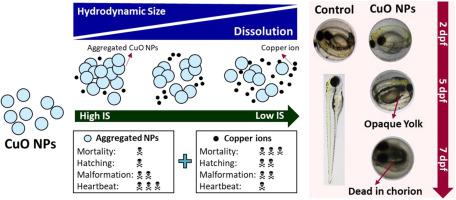Ecotoxicology and Environmental Safety ( IF 6.8 ) Pub Date : 2021-09-06 , DOI: 10.1016/j.ecoenv.2021.112759 Shu-Ju Chao , C.P. Huang , Chi-Cuong Lam , Lap-Cuong Hua , Shih-Hsien Chang , Chihpin Huang

|
This study aimed to investigate the transformation of copper oxide nanoparticles (CuO NPs) in aquatic environments under different ionic strength and further examine its effects on copper toxicity and bioaccumulation by monitoring the responses and uptake behaviours of zebrafish embryo. Ionic strength (IS) was simulated according to surface water (1.5 mM), groundwater (15 mM), and wastewater (54 mM), representing low-, mid-, and high-IS water, respectively. At the highest exposure of 10 mg CuO/L, zebrafish larvae mortality was increased from 21.3% to 33.3%, when IS decreased from 54 to 1.5 mM. Low-IS solution also caused the highest numbers of delayed hatching embryo (81.3%) and opaque yolk deformation (36.3%). Copper bioaccumulation markedly increased when larvae were exposed to low-IS water (35%) relative to high-IS water (15%). Exposing to low-IS particularly enhanced copper uptake (~15 ng Cu/g inside embryo), facilitating the copper accumulation in the heart of larvae, whereas aggregated CuO NPs (>500 nm) in mid- and high-IS water were blocked from the embryo and found abundantly in the body axis and tail. Results indicate that CuO NPs in low-IS solutions rapidly form the relatively small CuO NP aggregates with a high copper dissolution, which would pose great concern for aquatic organisms.
中文翻译:

离子强度对氧化铜纳米粒子的转化及其对斑马鱼胚胎铜毒性和生物蓄积性的影响
本研究旨在研究不同离子强度下水生环境中氧化铜纳米颗粒 (CuO NPs) 的转化,并通过监测斑马鱼胚胎的反应和吸收行为,进一步研究其对铜毒性和生物积累的影响。根据地表水 (1.5 mM)、地下水 (15 mM) 和废水 (54 mM) 模拟离子强度 (IS),分别代表低、中和高 IS 水。在 10 mg CuO/L 的最高暴露量下,当 IS 从 54 降至 1.5 mM 时,斑马鱼幼虫的死亡率从 21.3% 增加到 33.3%。低 IS 解决方案还导致孵化胚胎延迟 (81.3%) 和不透明蛋黄变形 (36.3%) 的数量最多。相对于高 IS 水 (15%),当幼虫暴露于低 IS 水 (35%) 时,铜的生物积累显着增加。暴露于低 IS 特别增强了铜的吸收(胚胎内约 15 ng Cu/g),促进了幼虫心脏中铜的积累,而在中高 IS 水中聚集的 CuO NPs(> 500 nm)被阻止从胚胎,在体轴和尾部大量发现。结果表明,低 IS 溶液中的 CuO NPs 迅速形成相对较小的 CuO NP 聚集体,具有较高的铜溶解度,这将对水生生物造成极大的关注。


























 京公网安备 11010802027423号
京公网安备 11010802027423号